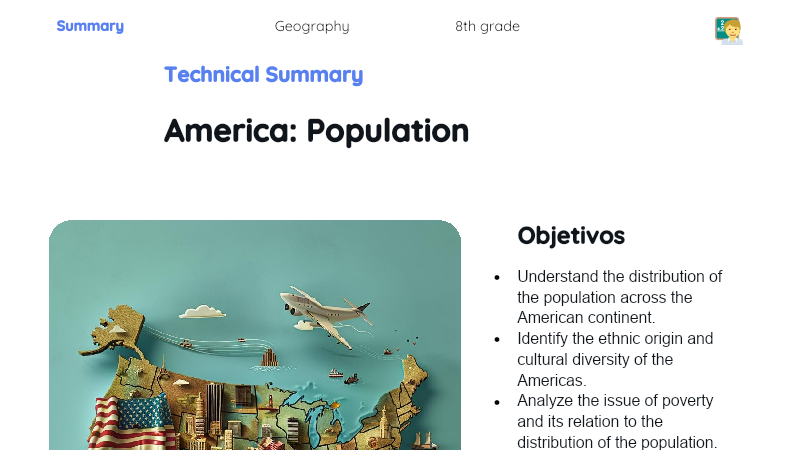Relevance of the Theme
Studying the characteristics of continents is essential in the discipline of Geography, as it allows us to understand the diversity and complexity of the world we live in. Oceania, the smallest continent in size and population, is a region full of singularities. Its geological formation, climate, flora and fauna, as well as the influence of colonization and globalization, are fundamental aspects that make up the mosaic of the continent. Therefore, knowing Oceania is a window to understanding the wonders and challenges of our planet.
Contextualization
The analysis of Oceania fits within the broader study of Geography, which includes understanding the physical, human, and environmental characteristics of specific regions of the world. At a macro level, Oceania contributes with peculiarities to the global scenario, whether in its European colonization, in the issues of independence of countries, or in the discussion about climate change and its implications for the islands in the region. In the curriculum of the 3rd year of High School, Oceania is configured as the first continent to be studied, being the starting point for a broader understanding of the world and global relations. Thus, exploring its characteristics is a way to address geographical, historical, political, and cultural aspects that shape our planet.
Theoretical Development
Components
-
Geology and Physical Geography:
- Formation: Oceania is a continent composed of islands, atolls, coral reefs, and underwater mountains. Its geological structure is relatively young, composed of volcanoes and tectonic structures resulting from the movement of tectonic plates.
- Structure: The islands of Oceania are grouped into three main sub-regions: Melanesia, Micronesia, and Polynesia, each with distinct geographical characteristics.
-
Climate:
- Influences: Oceania's climate is highly influenced by the trade winds, which bring abundant rainfall to coastal areas and deserts in some interiors of islands and smaller continents.
- Variety: Oceania presents a wide climatic variety, from humid tropical climates in coastal regions to desert climates in the interior of some smaller continents.
-
Flora and Fauna:
- Diversity: The flora and fauna of Oceania are incredibly diverse due to its geographical isolation. This diversity is most evident in Australia, which has a high rate of endemism (species that exist only in a specific region).
-
Colonization and Globalization:
- Influences: European colonization in Oceania, mainly in the 19th century, left deep cultural and political marks on the region. Furthermore, globalization has significantly influenced the economy and culture of Oceania.
Key Terms
-
Oceania:
- Definition: Also known as the insular continent, it is the smallest continent in territorial extension and population. It is located between the Pacific and Indian Oceans, including Australia, New Zealand, Papua New Guinea, and the island countries of the South Pacific.
-
Subcontinental Islands:
- Definition: Islands that are large and stable enough to have their own geography and ecology. Australia and New Zealand are considered subcontinental islands.
-
Atoll:
- Definition: A coral island in the shape of a ring or semicircle, surrounding a central lagoon. Atolls are found throughout the Pacific and are especially common in Micronesia and Polynesia.
Examples and Cases
-
Great Barrier Reef:
- Location: Located off the northeast coast of Australia, the Great Barrier Reef is a coral atoll that stretches for over 2,300 kilometers.
- Importance: It is the world's largest coral reef system and an important marine ecosystem, housing a huge variety of marine species.
-
Pitcairn:
- Location: The island of Pitcairn, a British Overseas Territory, is located in the southern Pacific Ocean.
- Curiosity: Pitcairn is the last mutiny of HMS Bounty and the settlers and their descendants make up the population.
-
Australia:
- Population: Australia is the most populous country in Oceania, with a population of approximately 25 million people.
- Diversity: Australia is marked by ethnic and cultural diversity, with significant influences from indigenous peoples, British, Asian, and Pacific peoples.
Detailed Summary
Relevant Points:
-
Geology and Physical Geography:
- Oceania is formed by islands, atolls, coral reefs, and underwater mountains, all resulting from geological processes.
- It is organized into three main sub-regions: Melanesia, Micronesia, and Polynesia. Within this spectrum, we find different geographical and geological formations.
-
Climate:
- Oceania's climate is highly diversified, ranging from humid tropical climates in coastal regions to desert climates in some smaller continental areas.
- The influence of trade winds is predominant in the distribution of rainfall and the formation of deserts.
-
Flora and Fauna:
- Oceania is known for its rich biodiversity, with distinct and diverse flora and fauna, especially in Australia, characterized by a high rate of endemism.
- The flora and fauna of Oceania are strongly influenced by its geography, isolation, and biological evolution.
-
Colonization and Globalization:
- European colonization played a significant role in the cultural and political formation of Oceania.
- Globalization has affected the region's economy and culture, bringing social and economic challenges and implications.
Conclusions:
-
Diversity and Singularity:
- Despite being the smallest continent in territorial extension and population, Oceania stands out for its diversity and singularity.
- Its geographical, climatic, biological, and cultural characteristics are unique and deserve attention.
-
Balance and Sustainability:
- The study of Oceania allows us to understand the importance of environmental balance and sustainability.
- Coral islands and delicate marine ecosystems, such as the Great Barrier Reef in Australia, are examples of how climate change and human action can irreversibly affect the environment.
-
Global Connections:
- Oceania is a key piece in understanding global interactions.
- The influence of European colonization and the impacts of globalization highlight the participation and interdependence of this continent in the world scenario.
Exercises:
- Describe the main geographical, climatic, flora and fauna, colonization, and globalization characteristics of Oceania.
- Explain the role of trade winds in the distribution of rainfall and desert formation in Oceania.
- Create an argument defending the importance of preserving the Great Barrier Reef and what can be done to ensure its survival.



